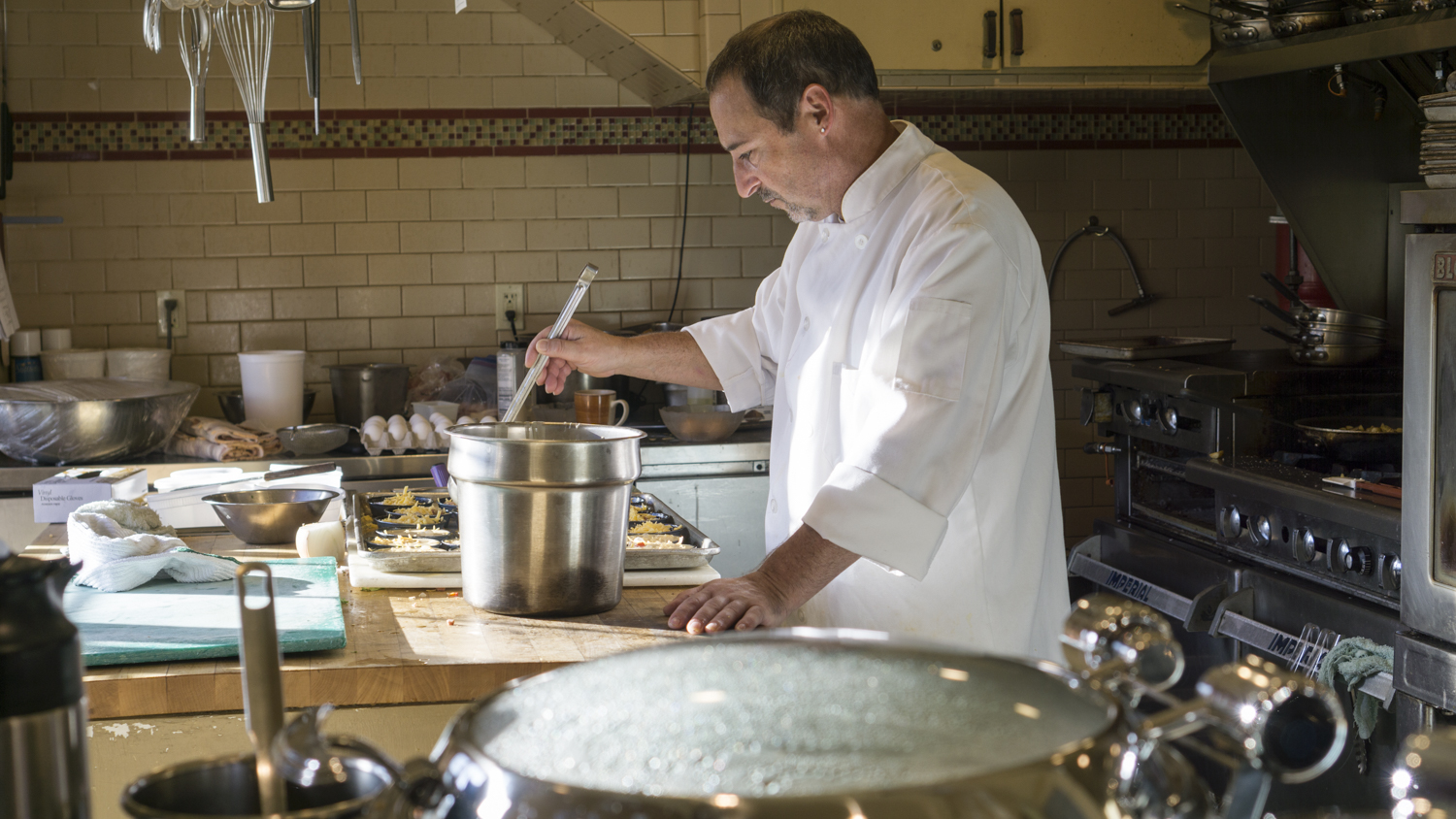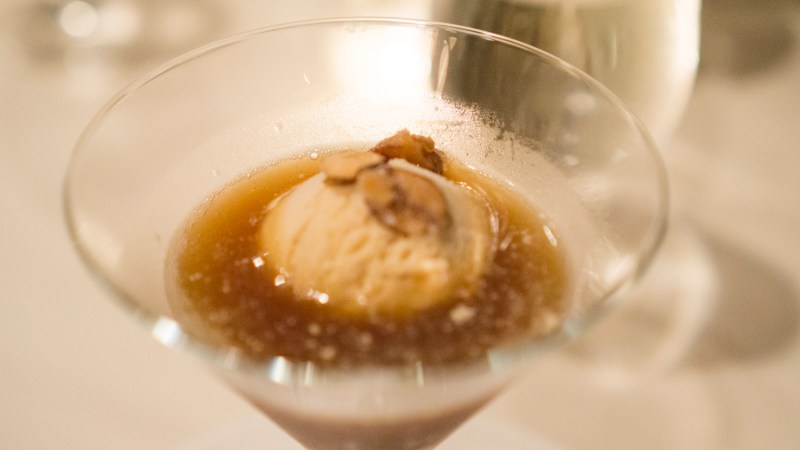Running parallel to the rocky, forest- and cove-lined coast of northern Oregon lies the Coast Range of mountains. There, in the verdant hills overlooking the often-fog shrouded and misty Pacific, are some of the best mushroom hunting lands in the entirety of the U.S. The Stephanie Inn also resides between the ocean and the mountains, sitting front-and-center on the world-renowned Cannon Beach (with Haystack Rock of The Goonies fame just off shore). It was here, through Stephanie Inn’s “Where the Wild Things Are” sojourn, that I spent a weekend learning about foraging for, cooking, and eating chanterelle mushrooms.
The Stephanie Inn is a 43-room, luxury inn with a primarily middle-aged and wealthier clientele looking for a quiet, relaxing, and romantic weekend away (though I did see several younger couples in the lounge and library). The Inn’s sojourn program is, as the Stephanie states itself, “A new guest experience program featuring one-of-a-kind, edible excursions and guided adventures with chef Aaron Bedard, in collaboration with other premier chefs, makers, artists, and outdoor experts.” Sojourns in 2017 included chocolate making; crabbing and fishing off the coast with a beach-side clambake; harvesting the coast, which involved oyster shucking, beach front cocktails, glass making, and learning about Jacobsen’s Sea Salt; and of course, the sojourn that I experienced, which concentrated on the identification and collection of mushroom species (specifically chanterelles) capped off with a lip-smacking, five-course foraged fall feast with accompanying wine and beer pairings.

My personal sojourn into the world of mushroom hunting began with my arrival at the Stephanie Inn the evening prior to the event’s commencement. There are 10 room types at the Inn to choose from, ranging from the least costly (but not less luxurious) mountain-view rooms to deluxe ocean-front corner suites and dormer rooms that boast breathtaking views of the entire arc of Cannon Beach and its sea-stacks just off-shore. I stayed in the Inn’s third-floor, oceanfront dormer room and couldn’t have asked for a better Pacific Northwest beach front experience. A super-sized king bed looked through a well-appointed living area with fireplace toward a spacious balcony, complete with super soft loungers and chairs and is the perfect spot for reading, sunbathing, or just lying around doing nothing. The bathrooms feature Jacuzzi Pure Air Baths, separate showers, and luxury toiletries; some rooms even have steam showers. All rooms come with a complimentary chef’s breakfast buffet of omelettes, eggs, bacon, sausage, hash browns, toast, and muffins with juices, teas, coffee, and every other kind of breakfast option you can imagine. Before heading out for the excursion, I loaded myself up with all the delicious foods, perhaps excessively so, all the while telling myself it was appropriate caloric preparation for five hours of hiking through Oregon forest.

I met the Sojourn group in lobby and was quickly introduced to Will Leroux, brewer at Public Coast Brewery, and avid mushroom hunter and fellow mushroom enthusiast Aaron Bedard, executive chef at the Stephanie Inn. With both men as our guides for the day, I set out with a group of far more well-to-do and important people who had traveled from around the country to revel in Leroux and Bedard’s expertise in both mushroom hunting and cooking. A short drive away from the Inn saw us winding our way into the foothills of the Coast Range and onto the property of a logging company where a few stands of old growth forest still exist and which Leroux knew to be a perfect spot for finding chanterelles since he had stumbled up on its location many years before.
It was there, at a straight line of trees created by a recent clear cut, that we began our descent deep into the forest. We had been given instructions on what to look for specifically when it came to chanterelles (though I won’t repeat that here since I refuse to be responsible for anyone’s mushroom-related poisonings), along with an informational packet (with images, thankfully), an airy basket for holding our spoils, a mushroom knife, an orange vest to warn hunters of our presence (it was deer season), and a whistle. The last component was emphasized as the most important, since great mushroom-hunting involves a lot of wandering and looking down, it’s not hard to find yourself lost, turned around, and way out of sight of anyone from your group. The whistle is an easy way to prevent what could be a day lost in the forest … or worse.

Armed with knowledge, a whistle, and the desire to gather the most, I quickly assessed the location that chanterelles preferred: south facing, on a slight slope with light fern and shrub coverage. With that in mind, I zig-zagged through the forest on my own, looking in places I thought matched with my previous assessment. It wasn’t long before I was proven right and found patch after patch of chanterelle mushrooms. But that wasn’t all that I found; I came across many other types of mushroom, most pretty deadly-looking, but some that were probably quite edible. Since I wasn’t sure, I left them to their own mysterious mushroom lives.
After a few hours of searching (and with a completely full basket), we all met at the edge of the trees for coffee, refreshments, and the obligatory competition to see who had gathered the most. I am more than ridiculously proud to say that my absurd dedication paid off and I was the winner. I accepted the weak round of applause with disproportionate pride.
At that time, we returned to the hotel for a lunch of soup and sandwiches highlighting chanterelles and a further educational period and cooking demonstration. The recipes below give you an idea of what we learned. And here are a few fun facts:
- There is no species of mushroom in which all the varieties are safe to eat.
- Some mushrooms are poisonous to some people and not to others.
- Chanterelles easily take on the flavor of whatever you cook them in, making them a perfect compliment for steak.
- Poricini mushrooms grow all over the world and show up after an inch of rain. They grow extremely quickly and some caps can be as large as a dinner plate. To cook these, cut lengthwise and sear in a cast iron pan, flipping only once if possible.
- Amanitas mushrooms are poisonous. Viking warriors supposedly ate them before battle to develop a form of hallucinogenic-derived courage.
- The best way to store fresh mushrooms is in a paper bag, a colander, or just on dry paper towel. Do not use plastic bags. Mushrooms require air circulation and most will last a week if stored following these methods.
There the sojourn ended for the day, but started up again that evening for a menu showcasing the seasonal bounty of the Pacific Northwest coast. The five-course meal included in the sojourn was beyond all expectations and took place in the Inn’s candlelit, atrium dining room. It was a truly memorable experience and even more so when I remembered that I had helped to harvest some of the mushrooms that I found on my plate.
Though all of the food was delicious, the absolute best dish was by far the Candy Cap Mushroom Float. Not only was the ice cream sweet, earthy, and creamy, it blended beauitfully with the beer and was really the pièce de résistance of the dinner. Below are a few recipes from the dinner, graciously provided by Chef Bedard and the Stephanie Inn.
Alder Scented Salmon
From Executive Chef Aaron Bedar, Stephanie Inn

Ingredients
- Eight 8 oz salmon fillets
- .75 cup non-iodized salt
- 1.5 cups brown sugar
- .5 cup soy sauce
- 3 bay leaves
- 1 tbs garlic powder
- 1 cup brandy
- 2 turns of a pepper grinder
- 2 dashes hot sauce (Tapatio or equivalent)
- 1.5 gallons water
- 2 tablespoons canola oil
Directions
- Combine all ingredients and stir until salt and sugar are dissolved.
- Place salmon in cold brine and let sit for 24 hours in refrigerator.
- Pull salmon out of brine after 24 hours and tap dry with paper towel. Place on wire rack and return to fridge for another 24 hours. Discard leftover brine.
- Place salmon in a bowl and cover with plastic wrap.
- Insert hose of smoking gun and smoke lightly for ten minutes.
- Remove salmon from bowl and season with salt and pepper.
- In a cast iron pan over medium heat, add 2 tablespoons canola oil.
- Sear salmon for three minutes on one side, flip over and finish in the oven at 350 degrees for ten minutes.
Candy Cap Mushroom Ice Cream
From Executive Chef Aaron Bedar, Stephanie Inn

Ingredients
- .75 oz dried candy cap mushrooms
- 1.5 cups heavy cream
- 1.5 cups milk
- half vanilla bean
- 8 egg yolks
- 8 oz white sugar
- 1 pinch salt
Directions
- Place mushrooms, cream, milk, and vanilla bean in a sauce pot on low heat and let steep for 15 minutes.
- Whisk egg yolks, sugar, and salt in a separate bowl.
- Slowly add hot cream to egg mixture, stirring constantly.
- Heat the mixture over a double boiler, while constantly stirring, until thickened and temperature is about 180 degrees.
- Pour mixture through a fine mesh strainer or four-layers of cheesecloth into a bowl and chill in an ice bath.
- Place chilled mixture in an ice cream maker and process until frozen. Place in containers to freeze solid.
- Once frozen, serve with an ice cream scoop.
If these recipes don’t strike your mushroom fancy, try out our mushroom pizza recipe.

















